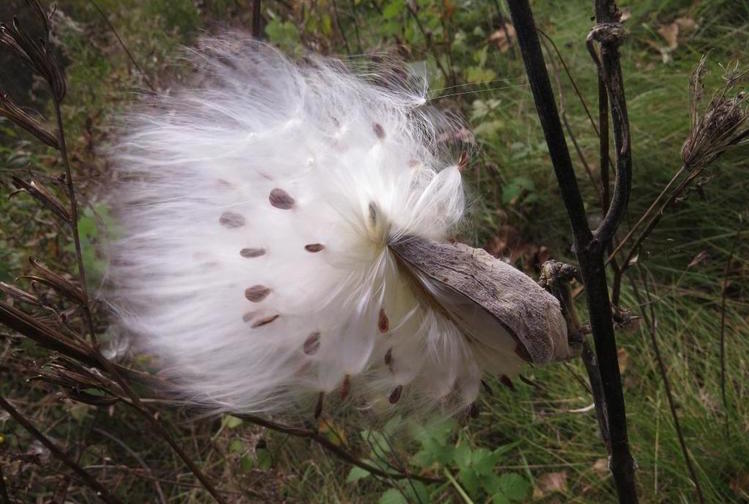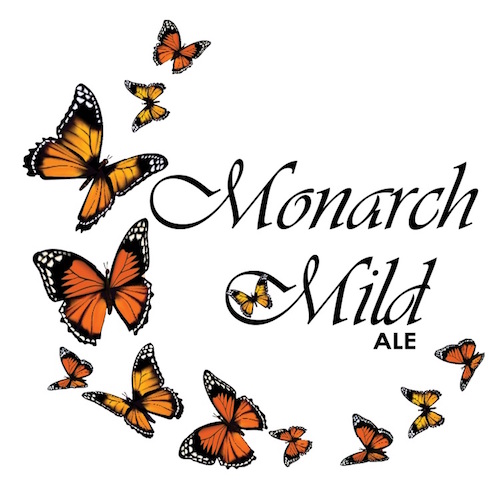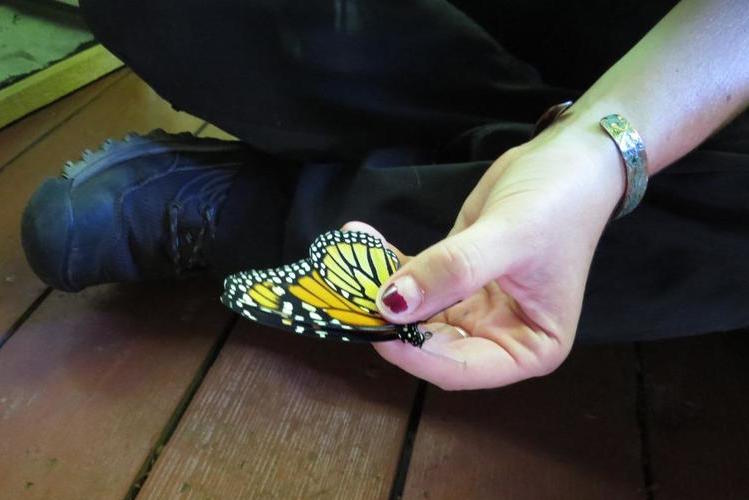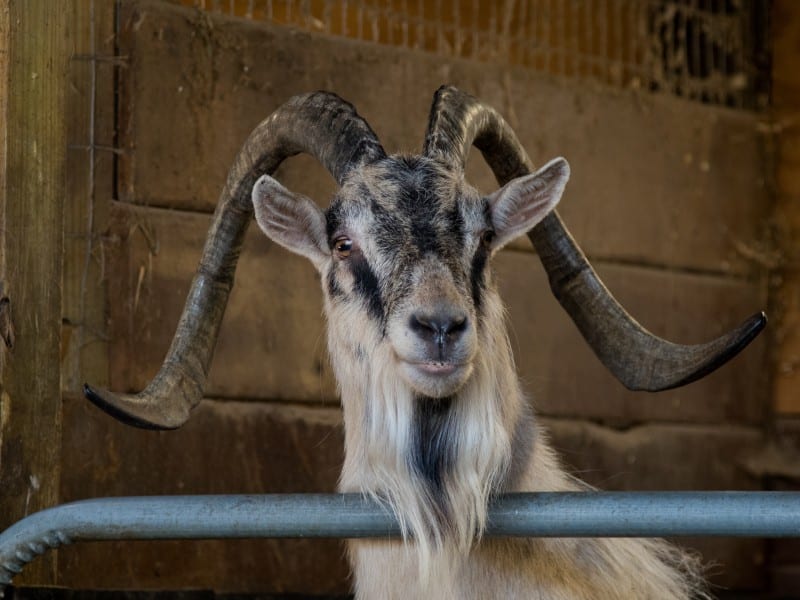Winging it: Of butterflies, beer (mostly butterflies), and travels with the Butterfly Lady
Monarchs are on the minds of those who care about growing plants. Here is what some local folks are doing about the butterfly's decline.
“Do people really call you the Butterfly Lady?” On a mid-September day, Ilse Gebhard invites me into her home and nods “yes” to the first of many questions: “People do call me the Monarch Lady and sometimes Butterfly Lady.” Her monarch rearing operation is in her living room.
Five Newman’s Own Salsa jars, each containing a chrysalis (the pupal stage) suspended from cotton cloth stretched over each jar, line a shelf atop a bookcase. The bookcase is usually full in the summer and fall, at times housing over 170 hungry caterpillars. Gebhard, a retired chemist, started raising monarchs nearly 20 years ago after finding a chrysalis on a plant in her yard.
In addition to raising monarchs at all four stages–egg, caterpillar, chrysalis and adult–she raises awareness about this pollinator in peril. A Conservation Specialist with Monarch Watch and Kalamazoo Area Wild Ones board member, Gebhard speaks to gardening and conservation groups and assists local gardeners in establishing insect-friendly habitats.
On a cold, drizzly late September evening, the “Butterfly Lady” presents at Wenke Greenhouses retail location in Kalamazoo, sharing knowledge about the monarch’s life cycle and the plants needed to sustain them: milkweed for the caterpillars (it’s all they eat) and nectar-rich flowers such as goldenrod and asters to build the butterflies’ fat reserves for their late fall migration to Mexico. Monarchs are tropical butterflies and cannot overwinter here. Surviving that migration is a long shot. They need good weather, light winds, and nectar sources along routes through the central U.S., into Texas and on to central Mexico, where they roost, clustered–tens of thousands of them–in fir forests nearly two miles above sea level through winter.
Gebhard presents graphs showing declines of up to 80 percent in monarch populations, the causes for which include agricultural chemicals for corn and soy that kill milkweed, habitat destruction from illegal logging in Mexico, widespread use of pesticides, and climate change. Gebhard offers milkweed seed packets and attendees are invited to sign a petition to help make the monarch Michigan’s official State insect. Nectar-rich native perennials from Hidden Savanna Nursery are displayed and discussed as food sources for butterflies and other pollinators.
After a lively Q & A, I ask the retail greenhouse owner and our host, Lisa Wenke Ambrosio, what led to Gebhard being invited to speak this evening. “Ilse approached us back in May about monarchs and pollinators,” she says. “We know the monarchs are in trouble, and we learned what we do for the monarchs helps all pollinators; it’s all related. Our retail customers and landscape designers are asking about pesticide-free native plants and we want to support them and their efforts to better our environment.”
Monarchs are also on the mind of Jen Tagett, Citizen Science Coordinator at the Kalamazoo Nature Center. Tagett leads the Center’s popular monarch tagging events on Tuesdays in September, which she sees as a way to highlight the insect’s “charismatic factor” given its beauty and phenomenon of migration, the only creature besides birds to do so. Visitors from as far away as Scotland and Germany have participated in these outings. The strong interest in monarchs, she believes, springs in part from a sense of urgency. “Something is about to be gone. People want to know what they can do.”
On the final tagging event of the season, Tagett leads our butterfly brigade, mostly children waving giant white nets, through the Emma Pitcher Prairie in search of monarchs. We don’t find one, so she demonstrates the tagging process on a recently emerged monarch housed in the Nature Center’s lobby. Sticky-backed white tags are about the diameter of a pencil eraser and light so as not to interfere with flight. Each has a unique number and letter identifier. Tagget explains the data is shared with and maintained by Monarch Watch as citizens submit information upon release of the adult butterflies and when found along their migratory routes. One of the children releases the tagged monarch to start its journey to Mexico.
Butterflies and beer
Mexican mole (MOE-lay) was the inspiration for Monarch Mild Ale, One Well Brewing’s collaboration beer with the Kalamazoo Nature Center. Head Brewer and Co-Owner, Chris O’Neill tells me “the five keg launch of the beer on Sept. 25, timed with Michigan’s monarch migration, aligns perfectly with the brewery’s mission to build solid community connections by sharing art, culture, ideas and beer.” And sharing there was, as a steady stream of folks approached Tagget and Ashley Wick, Biological Research Director, to talk and learn about butterflies. The Monarch Mild Ale, an English ale style beer, is wicked good and, like the traditional mole, contains chocolate, cinnamon, and a hint of heat. A portion of the beer sales proceeds was donated to the Nature Center.
Hospitals and schools, too, are contributing to pollinator protection. In Marshall, efforts are underway at Oaklawn Hospital to convert at least a quarter-acre of land adjacent to their community gardens into an insect-friendly habitat. Jonah Curtis and Dave Spranger (who submitted the idea through the hospital’s employee suggestion program) are leading the project and hope to have milkweed and some perennials sprouting by next summer.
At Mattawan Later Elementary School, Stephanie Comrie incorporates into her lesson plans and activities what she and two colleagues learned at a recent Monarch Teacher Network Workshop sponsored by Gebhard. Fourth graders grasp geography by studying migratory routes they follow at Journey North. Lessons on government are supplemented with writing letters to legislators in support of making the monarch our State insect. Observation and writing skills are fine-tuned by studying the monarch’s complete life cycle.
Soon the class will learn about El Dia de los Muertos, the Day of the Dead, a multi-day Mexican holiday in which friends and families pray for and remember lost loved ones. The holiday roughly coincides with Halloween and the arrival of the butterflies in central Mexico, where the monarchs symbolize past souls. “Just about every subject can be taught with monarchs,” Comrie says. “And once you learn about it, you care about it, you know?”
“Why should we care?” I asked Gebhard on that September day in her home as she talked about the decline in monarch populations. “It’s the migration phenomenon we are trying to save; it’s part of our natural history. Monarchs serve to represent all pollinators–the ‘poster child’ in a way. What we do by planting native trees and perennials so insects have habitat and food, by eliminating pesticides in our yards, and growing milkweed … all these efforts help to create and preserve a diverse ecosystem for insects and other wildlife.”
Donna McClurkan is expanding the pollinator garden on her farm in Southwest Michigan where she recently released four monarchs into the wild.


















